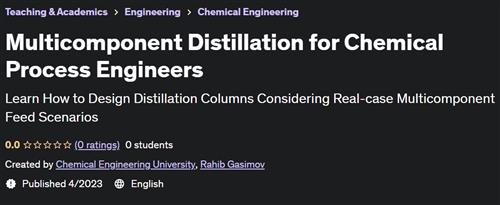

Free Download Multicomponent Distillation for Chemical Process Engineers
Published 4/2023
Created by Chemical Engineering University,Rahib Gasimov
MP4 | Video: h264, 1280x720 | Audio: AAC, 44.1 KHz, 2 Ch
Genre: eLearning | Language: English | Duration: 27 Lectures ( 2h 6m ) | Size: 1.5 GB
Learn How to Design Distillation Columns Considering Real-case Multicomponent Feed Scenarios
Free Download What you'll learn
Principles of Distillation Process
Principles of Multicomponent Distillation
How to Model Distillation of Multicomponent Feed
Model Rectifying and Stripping Sections of Distillation Column
Understand and Interpret "Number of Stages", "Reflux Ratio", "Tray Efficiency"
How to Implement Fenske Equation for Minimum Number of Stages
How to Implement Underwood Equations for Reflux Ratio
How to Implement Gilliland Correlations for Actual Number of Stages
Understand Design Considerations for Distillation Column
Requirements
Theory, background and practical sides of distillation are discussed here. No requirements for all levels of learners.
Description
Distillation refers to the selective boiling and subsequent condensation of a component in a liquid mixture. It is a separation technique that can be used to either increase the concentration of a particular component in the mixture or to obtain (almost) pure components from the mixture.The problem of determining the stage and reflux requirements for multicomponent distillations is much more complex than for binary mixtures.Multicomponent Distillation for Chemical Process Engineers training course will be the best fit in Udemy aiming to fill the needs for multicomponent distillation column design. The course is specifically designed to cover the principles of multicomponent distillation, distillation column design with Fenske-Underwood-Gilliland Method and column sizing by going over the following essential topics:Distillation Process OverviewDistillation Column and Supporting EquipmentDistillation PrinciplesOperating Challenges in Distillation ProcessDistillation Column DesignImplementation of Fenske and Underwood Equations for Number of Stages and Reflux Ratio CalculationsImplementation of Gilliland Correlations for Actual Number of Stages CalculationColumn Sizing Considerations, such as, Tray Efficiency, Operating Pressure, Height/Diameter Calculations, Process Control, etc.Above points have clearly been discussed during the course. This training can be really helpful for students, engineers and even teachers aiming to deliver the essentials of multicomponent distillation from engineering point of view. By spending only 2 hours, you can really understand the whole topic and further do practical calculations. Course instructor does also provide the service of answering questions for all course participants for free.
Who this course is for
Engineers working with Distillation Columns
Process Engineers
Chemical Engineers
Chemical Process Engineering Graduates or Undergraduates
Any Discipline Engineers aiming to learn essentials of distillation column sizing
Homepage
https://www.udemy.com/course/multicomponent-distillation-for-chemical-process-engineers/Buy Premium From My Links To Get Resumable Support,Max Speed & Support Me
Rapidgator
fsadj.M.D.f.C.P.E.part1.rar.html
fsadj.M.D.f.C.P.E.part2.rar.html
Uploadgig
fsadj.M.D.f.C.P.E.part1.rar
fsadj.M.D.f.C.P.E.part2.rar
NitroFlare
fsadj.M.D.f.C.P.E.part1.rar
fsadj.M.D.f.C.P.E.part2.rar
Links are Interchangeable - Single Extraction
Download File Free Multicomponent Distillation for Chemical Process Engineers
Fullwarezcrack.com is a great resource for anyone looking to download free tutorials, software, e-books. With a vast selection of tutorials and easy access to popular file hosting services, it's a one-stop-shop for all your tutorial needs. So why pay for expensive tutorials when you can get them all for free
Comments 0
No comments yet. Be the first!





